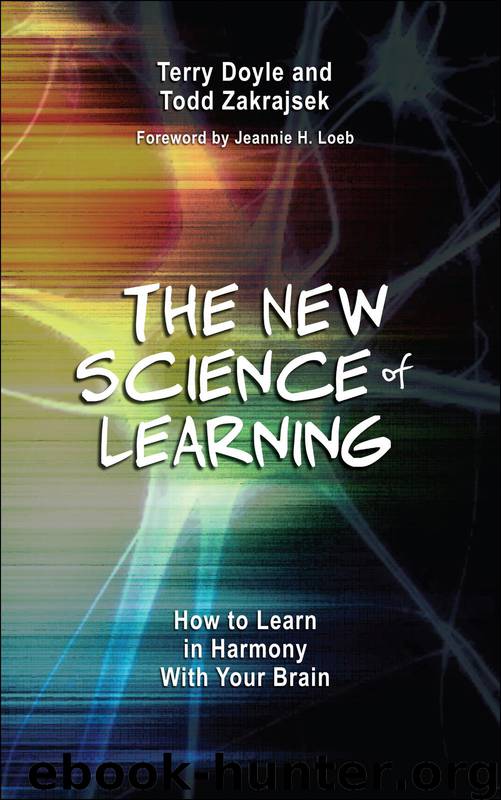The New Science of Learning: How to Learn in Harmony With Your Brain by Doyle Terry & Zakrajsek Todd

Author:Doyle, Terry & Zakrajsek, Todd [Doyle, Terry]
Language: eng
Format: azw3
Tags: Personal Growth, Success, Self-Help
ISBN: 9781620360095
Publisher: Stylus Publishing
Published: 2013-08-14T23:00:00+00:00
Figure 5.3 Proximity example.
XOXOXO
XOXOXO
XOXOXO
XOXOXO
As an example, suppose you are having a party and Joe walks in the door. Then, about 20 min later Sarah walks through the door. Your brain would typically not place Joe and Sarah together. Steve walks in the door about 5 min after Sarah, and Sam 10 s later. In that instant, without any purposeful work on your part, your brain would make the assumption that Steve and Sam came to the party together. Your brain establishes patterns quickly and then starts to construct meaning.
You establish similar patterns when you process course material as well. If your history professor talks about George Washington and then shortly afterward talks about the starting of a new nation, your brain will quickly assume that George Washington had something to do with the new country, even if you were not told this explicitly.
In addition, when events typically happen in close proximity, our brains often infer a cause-and-effect relationship. This assumption makes sense, as causes are often close to their respective outcomes. For example, if you see a person fall down and then seconds later notice a few marbles on the floor, your brain will quickly assume that the marbles caused the person to fall. This is why when something bad happens people believe it is a bad idea to be anywhere in the area. People’s brains are prewired to assume that they themselves are associated with the bad event and maybe even that they caused it. This cause-and-effect relationship determined by proximity is important in learning.
Proximity is one reason that it is a good idea not to schedule classes back-to-back and also to take a short break between study sessions when switching from one course curriculum to another. New information can become confusing if learned close to other new information because your brain will often try to establish patterns, even if none exist. This is particularly true when the subjects are relatively close. If you are taking both physics and math in the same semester, it might be helpful to put some space between the class sessions and study sessions for the two courses.
Proximity can also be used to your advantage. If you have complex material to learn, it is important to block off some time during which you can concentrate on that information. If people, a television program, or texts from friends distract you while you are studying, the material will lose its proximity, become less connected, and therefore be harder to learn.
Download
This site does not store any files on its server. We only index and link to content provided by other sites. Please contact the content providers to delete copyright contents if any and email us, we'll remove relevant links or contents immediately.
| Administration | Assessment |
| Educational Psychology | Experimental Methods |
| History | Language Experience Approach |
| Philosophy & Social Aspects | Reform & Policy |
| Research |
The Art of Coaching Workbook by Elena Aguilar(51004)
Trainspotting by Irvine Welsh(21524)
Twilight of the Idols With the Antichrist and Ecce Homo by Friedrich Nietzsche(18515)
Fangirl by Rainbow Rowell(9109)
Periodization Training for Sports by Tudor Bompa(8175)
Change Your Questions, Change Your Life by Marilee Adams(7641)
This Is How You Lose Her by Junot Diaz(6804)
Asking the Right Questions: A Guide to Critical Thinking by M. Neil Browne & Stuart M. Keeley(5664)
Grit by Angela Duckworth(5526)
Red Sparrow by Jason Matthews(5392)
Paper Towns by Green John(5094)
Room 212 by Kate Stewart(5041)
Ken Follett - World without end by Ken Follett(4647)
Housekeeping by Marilynne Robinson(4349)
The Sports Rules Book by Human Kinetics(4304)
Double Down (Diary of a Wimpy Kid Book 11) by Jeff Kinney(4210)
Papillon (English) by Henri Charrière(4200)
The Motorcycle Diaries by Ernesto Che Guevara(4020)
Exercise Technique Manual for Resistance Training by National Strength & Conditioning Association(3965)
